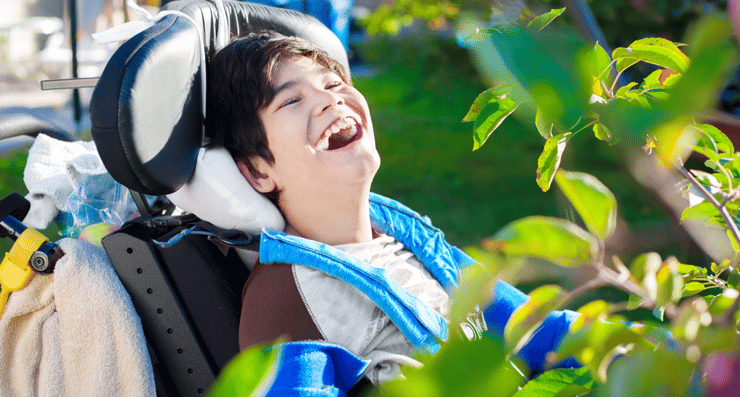
DEFINITION:
‘A Persistent but not unchanging disorder of posture
and movement, caused by damage to the developing
nervous system, before or during birth or in early months of
infancy’
- World Commission of Cerebral Palsy
CAUSES
:

ANTENATAL CAUSES
• Poor nutrition for mother
• Physical trauma
• Multiple births
• Infections of the mother while she is pregnant. These include
German measles and shingles (herpes zoster).
• Differences between the blood of mother and child (Rh
incompatibility).
• Problems of the mother, such as diabetes or toxemia of
pregnancy.
• Inherited. This is rare, but there is a 'familial spastic
paraplegia'.
• No cause can be found in about 30% of the children.

NATAL CAUSES:
• Lack of oxygen (air) at birth. The baby does not breathe
soon enough and becomes blue and limp. In some areas,
misuse of hormones (oxytocics) to speed up birth narrows
the blood vessels in the womb so much that the baby does
not get enough oxygen. The baby is born blue and limp-with
brain damage.
• Birth injuries from difficult births. These are mostly large
babies of mothers who are small or very young. The baby's
head may be pushed out of shape, blood vessels torn, and
the brain damaged.
• Prematurity, Low birth weight. Babies born before 9 months
and who weigh under 2 kilos (5 pounds) are much more
likely to have cerebral palsy. In rich countries, over half the
cases of cerebral palsy happen in babies that are born early.
• Cord around neck
• POST NATAL CAUSES:
• Very high fever due to infection or dehydration (water
loss from diarrhea). It is more common in bottle-fed
babies.
• Brain infections (meningitis, encephalitis). There are
many causes, including malaria and tuberculosis.
• Head injuries.
• Lack of oxygen from drowning, gas poisoning, or other
causes.
• Poisoning from lead glazes on pottery, pesticides
sprayed on crops, and other poisons.
• Bleeding or blood clots in the brain, often from unknown
cause.
• Brain tumors. These cause progressive brain damage in
which the signs are similar to cerebral palsy but steadily
get worse.
CLASSIFICATION
CLASSIFICATION BY TYPE
– Spastic
- Damage to the corticospinal tract, motor cortex,
or pyramidal tract
- Mainly the cerebrum. Charecterised by
hypertonicity.
– Ataxic
- Resulting from damage to the cerebellum.
Charecterised by hypotonia and tremors
• Athetoid/dyskinetic
- Damage to the extra pyramidal motor system and/or
pyramidal tract and to the basal ganglia.
- Characterized by mixed muscle tone - sometimes
hypertonia and sometimes hypotonia
- Often show involuntary motions.
• Mixed
- Mixure of any of the above three types can be seen
like, spastic athetoid
CLASSIFICATION BY TOPOGRAPHY:
∙ Spastic Hemiplegia
- One half of the body affected - Usually Contra
lateral
∙ Spastic Diplegia
- Whole body affected – lower limbs more affected
∙ Spastic Quadriplegia
- Whole body affected - all 4 limbs affected equally.
∙ Monoplegia
- Only one limb is affected,
∙ Paraplegia
- Both the lower limbs are affected
SIGNS AND SYMPTOMS :
• Abnormal muscle tone,
• Abnormal posture (i.e. slouching over while sitting),
• Exaggerated or diminished reflexes,
• Delayed motor development.
• Poor balance and coordination
ASSOCIATED PROBLEMS
• Other sensory problems- like visual or hearing deficit
• Mental retardation
• Dyslexia – learning disability
• Seizures
• Contractures and deformities
• Speech and language disorder
• Feeding disorder
• Behavioral problems
CONSERVATIVE MANAGEMENT
MEDICAL MANAGEMENT:
• Medications administered to control of the symptoms
prevent complications.
• Botulinum Toxin A (Botox) injections into muscles that are
either spastic or have contractures - Relieve the disability
and pain produced by the inappropriately contracting
muscle.
• Other medications
– Anticonvulsant medications for seizures.
– Anticholinergics to help manage uncontrollable body
movements (dystonic cerebral palsy) or frequent
drooling.
SURGICAL MANAGEMENT
• Surgery for people with CP usually involves one or a
combination of:
• Loosening tight muscles and releasing fixed joints, most
often performed on the hips, knees, hamstrings, and ankles,
commonly called as the tendon lengthening surgery. In
rare cases, this surgery may be used for people with stiffness
of their elbows, wrists, hands, and fingers.
• Straightening abnormal twists of the leg bones, i.e. femur
termed femoral anteversion or antetorsion and tibia - tibial
torsion. This is a secondary complication caused by the
spastic muscles generating abnormal forces on the bones,
and often results in intoeing (pigeon-toed gait). The surgery is
called derotation osteotomy, in which the bone is broken
(cut) and then set in the correct alignment
• Cutting nerves on the limbs most affected by movements
and spasms. This procedure, called a rhizotomy, "rhizo"
meaning root and "tomy" meaning "a cutting of“, reduces
spasms and allows more flexibility and control of the
affected limbs and joints
PHYSIOTHERAPY MANAGEMENT
AIMS:
• Reducing abnormal patterns of movement and posture
and promoting the normal ones.
• Reduce spasticity / maintaining near normal muscle tone
• Achieve near normal developmental milestones
• Prevent contractures and deformities
• Maintain and achieve functional independence
No comments:
Post a Comment